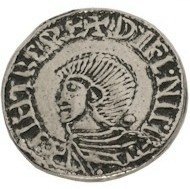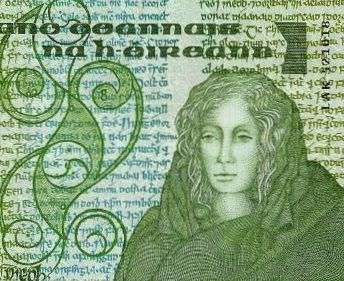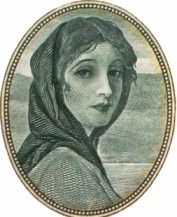Irish currency: a brief history of Ireland's money
The history of Irish currency reflects Ireland's political development over the last 1000 years. What began with the Vikings, who hammered out the very first Irish coins in Dublin in the 10th century, has left us with a marvellous legacy that marks social changes, political propaganda and economic trends. Indeed Irish coins and, more recently, banknotes, are outstanding historical documents.
Replica of the earliest irish coin:
King Sihtric silver penny, Dublin c.1000 AD.
The oldest Irish coins date to the Vikings
The very first Irish coins were struck by the Vikings in Dublin in about 997AD by order of their King Sihtric III, also known as Silkbeard. Until this time, a variety of coinage had circulated in Ireland, including Anglo-Saxon, western European and even Islamic from central Asia.
The new coins were copies of coins issued by King Ethelred II of England. Whenever the Anglo-Saxon king redesigned his coinage over the next two decades, the Vikings issued copy-cat versions.
After the Battle of Clontarf (1014), however, the Irish coin reverted to an earlier design for more than a century.
All the Irish coins produced had a one penny value, and were created (in theory) from a pennyweight of silver (one 240th of a pound weight). Over time, the quality and weight decreased, and the design became less and less legible.
Early medieval Irish currency
The arrival of the Anglo-Normans (1169/1171) introduced dramatic changes to the island, not least by the ceding of power to the English crown of the so-called Lordship of Ireland.
Currency from the period reflects this shift. Under King John (d 1216), Irish coins were struck in Kilkenny, Limerick and Waterford – the first to have been struck outside Dublin – and included silver halfpennies bearing a full frontal face. In the north, too, mintes were created at Downpatrick and Carrickfergus.
Coins minted in Ireland were easily distinguishable from English equivalents. Their inscription was usually specific, and their weight and design were different, too. In the 13th century, a triangle (rather than a circle) enclosed the reigning monarch's head. This occurred only on Irish currency.
14th century: Irish currency disappears
As the power of the Normans waned, mainly due to internal wrangling and external events and catastrophes, Gaelic society reasserted itself. It did not, however, give any priority to a formal money system, and the minting of coins petered out. Between 1310 and 1460, hardly any Irish coins were minted.
A variety of coins circulated, including worn English, Scottish and Irish coins, European tokens and a not-inconsiderable amount of forgeries.
1460 to 1900 in Ireland: money design
A new era for Irish currency began in 1460 when a new coinage was struck. Rather than just the penny coin, there were now a range of denominations, the highest being the groat (value, fourpence). These coins were struck not just in Dublin and the main cities of Cork, Galway and Limerick, but also in smaller regional centres such as Drogheda and Dublin.

Detail of a late 1970s Irish banknote depicting the Celtic Queen Meabh.
In 1979, Ireland broke its link with Sterling and floated on the international money markets. To mark the arrival of this fresh dawn for Irish currency, a new range of notes was issued, each featuring a person from history or mythology. Inscriptions were carried in both English and Irish. The Queen Meabh £1 note was withdrawn in 1990 when the £1 coin was launched.
The story of Irish currency over the next two and a half centuries is one that traces a period of political turmoil.
During the Cromwellian wars, for example, coinage showed little artistry (any old bit of metal was stamped with a date and used to pay troops), while King James II issued a copper coinage made from melted down cannons and church bells.
This latter coinage became known as 'gun money'; its face value had no connection to its metal content and it was quickly removed from circulation after 1690.
In 1800 the Act of Union attached Ireland politically to the rest of Britain. In terms of the country's currency, no impact was felt until 1826 when Ireland's distinctive coins became valueless.
For the next century Ireland had to use standard British sterling, both in coins and banknotes (a late 18th century innovation).
20th century Irish currency
Following its separation from the UK, the Irish Free State issued a new coinage. Some of the designs were to last until the Euro was introduced in 2002. The new Irish coins were quite radical at the time. Other than the harp, there was no obvious symbolism, the coins bearing only images of certain indigenous flora and fauna.
A range of banknotes was also introduced. These were designed by the Belfast-born artist Sir John Lavery and featured his rendition of an archetypal 'colleen'. It later transpired that the portrait was of his wife, Hazel, an American painter!.
The new Irish currency was pegged to sterling and was originally known as the Saorstát, or Free State, pound. After 1938, it became known simply as the Irish pound.
Lavery's notes (known as the A series) were issued on 10 September 1928 and, surviving decimalisation on 15 February 1971, remained in circulation until 1975/1977 when the B series was launched.
The latter featured five banknotes (no £100 note). Queen Maebh, the mythological queen of Connacht featured on the £1 note which was replaced by a coin in 1990 (see box above).
The rest of this series was taken out of circulation between 1989 and 1993 when the C series was introduced.
This final series of Irish pound banknotes was to be quite short-lived. Introduced in 1992/96, it was replaced by the Euro on 1st January 1999.
Initially, this new Irish currency existed only in accounting or cashless form. Irish coins and the C Series banknotes continued to ciculate. For most people, nothing appeared to have happened.
In September 1999 production of Irish euro coins began. Nine months later banknotes hit the presses.
By this time an intense period of education had begun to prepare the population for the final days of the Irish pound. Every household in Ireland was issued with an electronic converter and a Euro Handbook, and the final changeover to the new currency – on 1st January 2002 – went surprisingly smoothly. An estimated 85% of all public cash dispensers were issuing Euro by the end of the first day and within a week, nearly 90% of cash transactions were being carried out in Euro. .
A selection of Irish banknotes
from the 20th century
from the 20th century




No comments:
Post a Comment